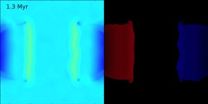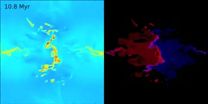(Press-News.org) When we learn, we associate a sensory experience either with other stimuli or with a certain type of behaviour. The neurons in the cerebral cortex that transmit the information modify the synaptic connections that they have with the other neurons. According to a generally-accepted model of synaptic plasticity, a neuron that communicates with others of the same kind emits an electrical impulse as well as activating its synapses transiently. This electrical pulse, combined with the signal received from other neurons, acts to stimulate the synapses. How is it that some neurons are caught up in the communication interplay even when they are barely connected? This is the crucial chicken-or-egg puzzle of synaptic plasticity that a team led by Anthony Holtmaat, professor in the Department of Basic Neurosciences in the Faculty of Medicine at UNIGE, is aiming to solve. The results of their research into memory in silent neurons can be found in the latest edition of Nature.
Learning and memory are governed by a mechanism of sustainable synaptic strengthening. When we embark on a learning experience, our brain associates a sensory experience either with other stimuli or with a certain form of behaviour. The neurons in the cerebral cortex responsible for ensuring the transmission of the relevant information, then modify the synaptic connections that they have with other neurons. This is the very arrangement that subsequently enables the brain to optimise the way information is processed when it is met again, as well as predicting its consequences.
Neuroscientists typically induce electrical pulses in the neurons artificially in order to perform research on synaptic mechanisms.
The neuroscientists from UNIGE, however, chose a different approach in their attempt to discover what happens naturally in the neurons when they receive sensory stimuli. They observed the cerebral cortices of mice whose whiskers were repeatedly stimulated mechanically without an artificially-induced electrical pulse. The rodents use their whiskers as a sensor for navigating and interacting; they are, therefore, a key element for perception in mice.
An extremely low signal is enough
By observing these natural stimuli, professor Holtmaat's team was able to demonstrate that sensory stimulus alone can generate long-term synaptic strengthening without the neuron discharging either an induced or natural electrical pulse. As a result – and contrary to what was previously believed – the synapses will be strengthened even when the neurons involved in a stimulus remain silent.In addition, if the sensory stimulation lasts over time, the synapses become so strong that the neuron in turn is activated and becomes fully engaged in the neural network. Once activated, the neuron can then further strengthen the synapses in a forwards and backwards movement. These findings could solve the brain's "What came first?" mystery, as they make it possible to examine all the synaptic pathways that contribute to memory, rather than focusing on whether it is the synapsis or the neuron that activates the other.
The entire brain is mobilised
A second discovery lay in store for the researchers. During the same experiment, they were also able to establish that the stimuli that were most effective in strengthening the synapses came from secondary, non-cortical brain regions rather than major cortical pathways (which convey actual sensory information). Accordingly, storing information would simply require the co-activation of several synaptic pathways in the neuron, even if the latter remains silent.
These findings may also have important implications both for the way we understand learning mechanisms and for therapeutic possibilities, in particular for rehabilitation following a stroke or in neurodegenerative disorders. As professor Holtmaat explains: "It is possible that sensory stimulation, when combined with another activity (motor activity, for example), works better for strengthening synaptic connections". The professor concludes: "In the context of therapy, you could combine two different stimuli as a way of enhancing the effectiveness."
INFORMATION:
Memory in silent neurons
2014-08-31
ELSE PRESS RELEASES FROM THIS DATE:
A new synthetic amino acid for an emerging class of drugs
2014-08-31
One of the greatest challenges in modern medicine is developing drugs that are highly effective against a target, but with minimal toxicity and side-effects to the patient. Such properties are directly related to the 3D structure of the drug molecule. Ideally, the drug should have a shape that is perfectly complementary to a disease-causing target, so that it binds it with high specificity. Publishing in Nature Chemistry, EPFL scientists have developed a synthetic amino acid that can impact the 3D structure of bioactive peptides and enhance their potency.
Peptides and ...
Discovery reveals how bacteria distinguish harmful vs. helpful viruses
2014-08-31
When they are not busy attacking us, germs go after each other. But when viruses invade bacteria, it doesn't always spell disaster for the infected microbes: Sometimes viruses actually carry helpful genes that a bacterium can harness to, say, expand its diet or better attack its own hosts.
Scientists have assumed the bacterial version of an immune system would robotically destroy anything it recognized as invading viral genes. However, new experiments at Rockefeller University have now revealed that one variety of the bacterial immune system known as the CRISPR-Cas system ...
Why sibling stars look alike: Early, fast mixing in star-birth clouds
2014-08-31
VIDEO:
This 11-second movie shows a computational simulation of a collision of two converging streams of interstellar gas, leading to collapse and formation of a star cluster at the center. Face-on...
Click here for more information.
Stars are made mostly of hydrogen and helium, but they also contain trace amounts of other elements, such as carbon, oxygen, iron, and even more exotic substances. By carefully measuring the wavelengths (colors) of light coming from a star, astronomers ...
Mixing in star-forming clouds explains why sibling stars look alike
2014-08-31
VIDEO:
This computer simulation shows the collision of two streams of interstellar gas, leading to gravitational collapse of the gas and the formation of a star cluster at the center. The...
Click here for more information.
The chemical uniformity of stars in the same cluster is the result of turbulent mixing in the clouds of gas where star formation occurs, according to a study by astrophysicists at the University of California, Santa Cruz. Their results, published August 31 in ...
Antarctic sea-level rising faster than global rate
2014-08-31
A new study of satellite data from the last 19 years reveals that fresh water from melting glaciers has caused the sea-level around the coast of Antarctica to rise by 2cm more than the global average of 6cm.
Researchers at the University of Southampton detected the rapid rise in sea-level by studying satellite scans of a region that spans more than a million square kilometres.
The melting of the Antarctic ice sheet and the thinning of floating ice shelves has contributed an excess of around 350 gigatonnes of freshwater to the surrounding ocean. This has led to a reduction ...
Changing global diets is vital to reducing climate change
2014-08-31
A new study, published today in Nature Climate Change, suggests that – if current trends continue – food production alone will reach, if not exceed, the global targets for total greenhouse gas (GHG) emissions in 2050.
The study's authors say we should all think carefully about the food we choose and its environmental impact. A shift to healthier diets across the world is just one of a number of actions that need to be taken to avoid dangerous climate change and ensure there is enough food for all.
As populations rise and global tastes shift towards meat-heavy Western ...
A new way to diagnose malaria
2014-08-31
CAMBRIDGE, MA -- Over the past several decades, malaria diagnosis has changed very little. After taking a blood sample from a patient, a technician smears the blood across a glass slide, stains it with a special dye, and looks under a microscope for the Plasmodium parasite, which causes the disease. This approach gives an accurate count of how many parasites are in the blood — an important measure of disease severity — but is not ideal because there is potential for human error.
A research team from the Singapore-MIT Alliance for Research and Technology (SMART) has now ...
Memory and Alzheimer's: Towards a better comprehension of the dynamic mechanisms
2014-08-31
This news release is available in French. Montréal, August 31, 2014 – A study just published in the prestigious Nature Neuroscience journal by, Sylvain Williams, PhD, and his team, of the Research Centre of the Douglas Mental Health University Institute and McGill University, opens the door towards better understanding of the neural circuitry and dynamic mechanisms controlling memory as well of the role of an essential element of the hippocampus – a sub-region named the subiculum.
In 2009, they developed a unique approach – namely, the in vitro preparation of a hippocampal ...
Renal denervation reduces recurrent AF after ablation
2014-08-31
Barcelona, Spain – Sunday 31 August 2014: Renal denervation reduces recurrent atrial fibrillation (AF) when performed with pulmonary vein isolation ablation in patients with AF and hypertension, according to research presented at ESC Congress today by Dr Alexander Romanov from the Russian Federation.
Dr Romanov said: "The prevalence of AF ranges from 1.5 to 2% in developed countries. This arrhythmia is associated with increased mortality, a five-fold risk of stroke and a 3-fold incidence of congestive heart failure. The vast majority of patients with AF also have arterial ...
Energy drinks cause heart problems
2014-08-31
Barcelona, Spain – Sunday 31 August 2014: Energy drinks can cause heart problems according to research presented at ESC Congress 2014 today by Professor Milou-Daniel Drici from France.
Professor Drici said: "So-called 'energy drinks' are popular in dance clubs and during physical exercise, with people sometimes consuming a number of drinks one after the other. This situation can lead to a number of adverse conditions including angina, cardiac arrhythmia (irregular heartbeat) and even sudden death."
He added: "Around 96% of these drinks contain caffeine, with a typical ...





